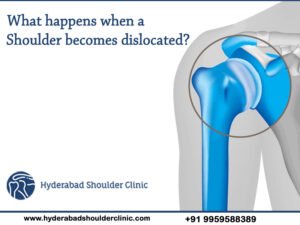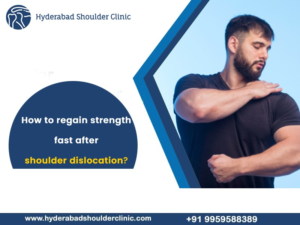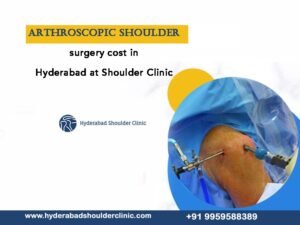The shoulder is the most flexible joint in the body because it can rotate in many directions. A shoulder dislocation is a painful and debilitating injury. Some sports and activities increase the risk of shoulder dislocation, including contact sports such as soccer, hockey and sports that are more prone to falls, such as volleyball or skiing. Shoulder dislocation doesn’t always result from playing sports or being outside, any fall or a strong blow to the shoulder can cause a sprain.
Shoulder dislocation is common because the shoulder joint’s ability to move in multiple directions also makes it unstable. The bone on the top of your arm, called the humerus, has a ball-shaped structure called the humeral head on top and articulates with a socket-shaped opening, an indentation at the end of the scapula (glenoid ). If you fall on the shoulder joint or if something hits you hard in this area, the humeral head can pop out from its socket because only soft tissue and tendons hold it in place.
Dr Chandra Shekar. B provides information about Dislocated Shoulder Symptoms, Repair, and Recovery Time.
What is a shoulder dislocation?

If your shoulder is suddenly injured or your arm is twisted, it can cause the head of the shoulder blade socket’s upper arm to pop out. There are two types of shoulder sprains: partial and complete.
- Partial: Partial dislocations are called subluxations. Subluxation occurs when the ball and socket lose some contact. A subluxation of 50% indicates that the articular surface has lost half of its contact.
- Complete: Complete dislocation means that 100% of sublimation has occurred, and all articular surfaces have lost all contact. If you suspect a sprained shoulder, see a doctor immediately.
Symptoms

Shoulder dislocation signs and symptoms can include:
- The shoulder that appears deformed
- Swelling or bruising
- Pain
- The impossibility of moving the joint
A sprained shoulder can also cause numbness, weakness, or tingling in the neck or the arm. The muscles in your shoulder may cramp after you rest, which often increases the pain’s intensity.
When to see a doctor
See a doctor immediately if you notice a dislocated shoulder. While waiting for medical help:
- Don’t move the joint. Use Splint or sling to keep the joint in its current position. Don’t try to move your shoulders or push back. If you move an injured shoulder, it can damage the shoulder joint and surrounding muscles, ligaments, nerves, or blood vessels.
- Ice the injured area. Applying ice to your shoulder can help relieve pain by controlling internal bleeding and swelling by reducing fluid buildup in and around your shoulder joint.
Shoulder repair

If your shoulder dislocates, you should see a doctor as quickly as possible. The longer you wait, the more the soft tissue in your shoulder will swell, making it more challenging to put back the humeral head into its socket. Hence, shoulder dislocation requires an immediate visit to the emergency hospital or clinic.
When you arrive at the clinic, your doctor will order an x-ray to determine which direction you dislocated your shoulder as this affects the reset approach. Your doctor will enquire how you dislocated your shoulder and whether it happened before. The actual process of resetting the arm back into its socket is called closed reduction, which takes a few minutes. However, the recovery time after the process tends to be longer.
How to treat shoulder dislocation

For many shoulder dislocations, the shoulder surgeon uses conservative methods to manage symptoms after the humerus is reinserted into the humeral fossa. Your doctor may recommend the following non-surgical treatments aimed at reducing pain and swelling and restore function:
- Activity modification and immobilization using the sling
- Anti-inflammatory drugs
- Icing or hot application to the shoulder joint
- Strengthening exercises or physical therapy
If your shoulder dislocation is severe and is accompanied by torn ligaments and tendons, one may need surgery. We offer the latest surgical techniques for treating shoulder dislocations and soft tissue injuries, including a minimally invasive approach that allows for faster recovery times and reduced shoulder pain. Your doctor will discuss surgical options depending on your situation.
Surgery:
Shoulder dislocation surgery repairs the damage that occurs when the shoulder pops out of its socket. This may include repairing torn ligaments and tendons or repairing other fractures that may have occurred during the injury.
Our shoulder surgeons have extensive experience performing complex surgical procedures for shoulder injuries, including tendon and tendon reconstruction or removal. Our shoulder surgeons perform many of these specialized surgical procedures, which restore shoulder function and strength and relieve shoulder pain.
Shoulder dislocation operations offered:
Advanced arthroscopic techniques

Shoulder surgeons often use minimally invasive arthroscopic techniques to repair soft tissue and fractures caused by dislocated shoulders. Your surgeon will make a small incision on your shoulder area and insert a very thin tube called an arthroscope with a little light for guidance and a camera for visualization. This camera allows the surgeon to see structures in and around the shoulder joint and then doctor repair and reconstruct ligaments and tendons, and other fractures. The arthroscopic surgical technique allows for faster recovery time and less pain.
Reconstruction and repair of tendons and ligaments
Torn tendons and ligaments often accompany a sprained shoulder and may need tendon and ligament reconstruction to repair the damage. Using advanced arthroscopic techniques, the orthopaedic surgeon performs tendon or tendon reconstruction or transfer to improve function and reduce shoulder instability. By strengthening and repairing the shoulder’s tendons and ligaments, the risk of the shoulder’s future recurrent dislocation is reduced.
Transfer and bone transplant

An injury may damage the humeral fossa (glenoid) or ball (humeral head) bone after dislocating the shoulder in certain situations. To stabilize the shoulder and prevent further sprains, a piece of bone may need to be moved from another location in the shoulder or body to the glans penis or head of the shoulder.
This is done in conjunction with tendon reconstruction and is done arthroscopically or through an incision in your shoulder. Our shoulder surgeons are experienced with these surgical techniques and will discuss the best treatment options with you to improve function and reduce shoulder instability.
Shoulder dislocation recovery
After a shoulder dislocation, your arm will be placed in the sling for about four to six weeks while you heal. Your doctor will immediately begin your pain management program and, once you are ready, physical exercise to restore strength and mobility.
Recovery from a shoulder sprain can take several months, depending on the type of surgery and the speed at which it is healing. Your shoulder team will give a tailor-made rehabilitation and recovery program to assist your condition.
Physical therapists, shoulder surgeons, and pain therapists work together to develop a personalized rehabilitation plan that fits your individual recovery needs and goals. Our rehabilitation program offers comprehensive care for each phase of recovery until maximum function and mobility are restored.
Recovery Time

If your shoulder dislocation is severe or your shoulder sprains frequently, surgery may need to repair the damage. However, most shoulder sprains heal very well with non-surgical treatment. In general, the time it takes to recover from a sprained shoulder can vary from one to three months. Note, however, that this is only an estimate. It is highly recommended following your doctor’s advice to speed up your recovery.
So make sure to listen to your doctor and do what the doctors recommend.
Recovery tips
To heal your dislocated shoulder, you will need to repair the shoulder in the sling frequently, usually for several weeks. The most severe pain will stop once your shoulder is back in place, but you will likely experience mild discomfort after that. Ice and anti-inflammatory drugs are usually recommended to deal with pain. As your shoulder heals, your doctor will likely prescribe exercises to strengthen your shoulder and prevent further sprains. You can do this by seeing a physical therapist, or your doctor can provide a program for you to do at home.
Recovery milestones:
After six weeks of therapy and rehabilitation, the affected arm can usually be used relatively normally, except for avoiding strenuous body or overhead movements and strenuous activities such as heavy lifting or push-ups.
Resumption of work
If you have a sedentary office job, you can usually return to work 1 to 2 weeks after surgery. Mild manual labour can resume after 3 or 4 weeks, but full service may have to wait for 3 to 6 months, depending on the patient’s specific job and rehabilitation plan.
Get back to driving

Patients can resume driving as soon as the affected arm is no longer in the sling, and the shoulder muscles have healed, ideally after 4 to 6 weeks.
Participation in sports
People who exercise should consult their doctor about permission to return to sports. Activities like golf or swimming can be approved after about six weeks. However, doing strenuous sports that can affect the shoulders, such as football or volleyball, requires several rehabilitation months before people can continue playing.
It can take up to a year for the shoulder strength and activity to fully recover. However, most patients who follow a rehabilitation plan and protect their shoulder can expect a full return to pre-injury activities.
Conclusion:
You can reduce your risk of recurring shoulder sprains by following the physical therapy plan recommended by your doctor to strengthen and stabilize your shoulder.
If your shoulder is sprained, the first step to getting better health is to see a shoulder surgeon for diagnosis, treatment, and recovery. Dr Chandra Shekar. B is an experienced shoulder surgeon who is dedicated to providing holistic, specialized and high-quality care. Call to make an appointment today.





